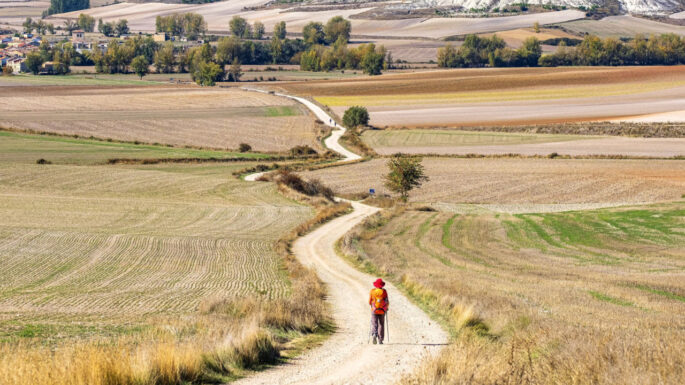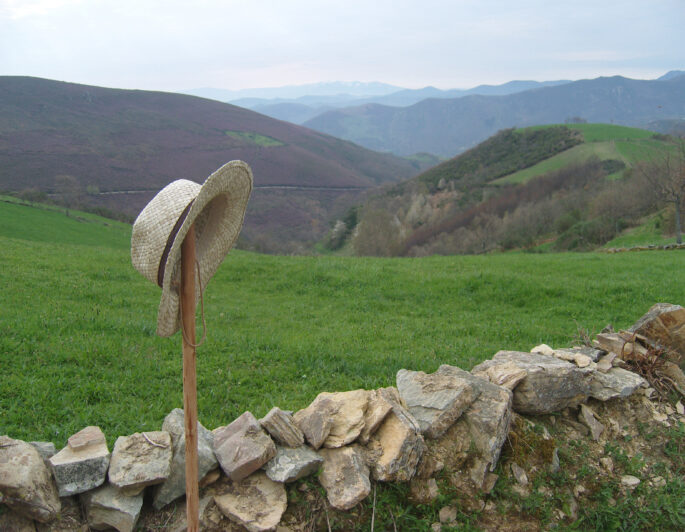
What if the very part of you that’s afraid isn’t something to overcome or escape—but something to embrace? What if your most profound growth lies hidden not beyond fear, but within it?
The Camino de Santiago isn’t an escape. It’s not a vacation or a getaway. It’s a voluntary confrontation with the parts of yourself that have been hiding behind defensive walls, waiting for recognition, understanding, and compassion. Long hours of walking through landscapes shaped by time, human sacrifice, and sacred intention, moments of solitude, and the embodied rhythm of pilgrimage all work together to strip away distractions. What you’re left with is something most of us avoid—silence, vulnerability, and shadow.
But this is where real healing begins. As Carl Jung wrote, “One does not become enlightened by imagining figures of light, but by making the darkness conscious.” Shadow work is the process of retrieving the parts of ourselves we’ve buried—parts we thought were weaknesses, but that, in truth, carry vital lessons and hidden strengths. Pilgrimage, like deep therapy, is a space to confront and integrate these buried parts and discover their gems.
This kind of healing isn’t about comfort or escape. It’s about stepping directly into the challenges we instinctively avoid, not to defeat them but to grow through them. Modern life has conditioned us to believe that hardship is avoidable and that if we encounter pain, grief, or crisis, we have failed. But life is hard—and to deny that truth is to deny life itself. In our pursuit of comfort and convenience, we’ve atrophied our ability to endure hardship and find meaning in it. Pilgrimage reverses this. It is a return to the ancient wisdom that growth comes not from avoiding struggle but by embracing it with initiatory eyes.
I invite you to think of this essay as your first step. Below is an assignment that mirrors what we will be doing on the Camino: immersing ourselves in the physical, emotional, and spiritual challenges we usually avoid, not to defeat them, but to integrate them, and grow more resilient as a result.
Assignment: Walking with the Shadow
- Find a Space for Solitude: Whether in nature, a quiet room, or even while walking, set aside 30 minutes. This isn’t a casual exercise—it’s an act of courage, a conversation with the part of you that’s been waiting to be heard.
- Journal Prompt: What part of me feels abandoned, ignored, or misunderstood?
Begin by asking yourself: What fear or insecurity arises when I am alone? What emotions do I most want to distract myself from?
Don’t try to analyze or fix what arises. Just observe. Does a memory surface? A feeling of inadequacy? An old wound you thought had healed but still aches? Imagine this fear or wound as a part of you—a fragmented version of yourself, perhaps from childhood or another time of vulnerability. What does it have to say? Perhaps it emerges as a symbol, image, or vague feeling tone. Can you stay with it, and relate to long enough with receptivity until some deeper wisdom emerges? - Receptivity, Not Rejection: Healing requires empathic receptivity, not avoidance. Ask yourself:
- What is this part of me protecting? What pain is it guarding against?
- How have I built walls to avoid this part of myself? What has this avoidance cost me—emotionally, spiritually, or in relationships?
- If I stopped running from this wound and instead walked toward it with compassion, what might it reveal to me about my deeper needs or longings?
- Therapy in Motion: If possible, take this reflection outdoors. Walk slowly and deliberately. Let the motion of your body metabolize the internal emotions. Walking in nature mirrors the natural rhythm of healing—unhurried, gradual, and cyclical. The body keeps the score, and holds the wound, but also possesses the innate medicine of intuitive love and understanding. We don’t have to overanalyze everything, in many cases this is just a hidden aspect of the defense. Notice the way the world around you moves without force. Let your body be your guide.
- Recollection: Gathering the Fragments
In your journal, or contemplation answer the following:- What would it mean to reunite with this wounded part of myself rather than push it away?
- How could I begin to integrate its message instead of fearing it?
- What wisdom is this shadow offering me that I’ve been unwilling to see?
- How can I expand to include both the wound and the wisdom within it, so that they are held simultaneously within me?
The Role of Challenge and Adversity in Growth
Pilgrimage forces us to encounter challenges that modern life allows us to avoid. But hardship is not the enemy; it’s the gateway. On past pilgrimages, my groups have faced unexpected adversity that, at the time, felt overwhelming—but in hindsight, proved to be the very catalyst for transformation:
- In Sri Lanka (2019), we experienced the Easter Terrorist Attacks shortly before embarking on pilgrimage. There was a moment when people doubted if it was safe to embark. It wasn’t easy to continue, but what emerged was solidarity—not just with each other, but with the people of Sri Lanka. Fear was transformed into an act of collective compassion.
- In Nepal and India (2022), we became one of the first pilgrim groups to cross the border between the two countries post-pandemic, only to be met with logistical breakdowns and miscommunication. Rather than give in to frustration, the group rallied together and found strength, patience, humor, and gratitude in collective problem-solving. Our emblematic catch phrase #flowlikewater still resonates with us today.
- In Bali (2023), after a water purification ritual at a 10th-century temple, half the group fell ill for days. Many reported that during their recovery, isolated in their rooms, they experienced breakthroughs in clarity and meaning. The physical obstacles and forced stillness became fertile ground for insight.
- In Japan (2024), the cultural precision and refinement we admired revealed its shadow—rigidity, inflexibility, and emotional distance. This cultural tension wasn’t easy to process, but by confronting it, the group learned to integrate light and dark, recognizing the wisdom in discipline without becoming imprisoned by it.
In all these cases, adversity wasn’t a failure—it was an initiation. On the Camino de Santiago, this will be no different. We won’t go looking for hardship, outer obstacles and inner shadow, but the pilgrimage will naturally activate and present these challenges, and when it does, we’ll be ready to meet them with meaning and growth as our goal.
The Therapeutic Power of Pilgrimage

This is why pilgrimage works and why I consider it a type of therapy. It combines the most effective therapeutic elements to guide you through the shadow and into integration:
- Immersion in Nature: Nature itself is healing. As you walk, the natural world reflects your inner process, teaching you patience and resilience, inspiring awe, stillness, and wonder.
- Disconnecting from Distractions: The absence of distractions, work commitments, technology, and social media, allows you to confront what you’ve been suppressing, inviting the unconscious to surface.
- Solitude and Reflection: Solitude is not loneliness—it’s a sacred space where deep reflection becomes possible. You are your own crucible.
- Processing Deep Grief or Sorrow: Walking is a form of physical release. With each step, the body activates, processes, and metabolizes emotions that words cannot reach.
- Reclaiming Agency, Vision, and Purpose: By voluntarily facing your fears and limits, you reclaim the power to rewrite your life’s narrative and take bold steps toward rebuilding your life.
- Group Support: Pilgrimage is individual but never solitary. The group becomes a source of strength, reflection, and shared breakthroughs. Most of us long for these deep bonds that remind us we are human in a digital and disconnected age.
- Legacy, Lineage, and Holy Sites: The sacred nature of pilgrimage sites connects you to something larger, a legacy or lineage imbued with power, offering spiritual nourishment and guidance.
- Healing the Root Cause: Our Disconnection from Spirit: What I call “paradigm sickness” is the spiritual malaise of modern life that has left us feeling empty. Pilgrimage reconnects you to your soul, addressing this root disconnection and restoring wholeness.
Take This First Step
This month, I encourage you to try the assignment. Engage with the part of you that’s afraid, not simply to “let the fear go” as some casually suggest, but to step into it as Joseph Campbell suggests, approaching the innermost cave. Healing isn’t about rejecting your pain; it’s about learning what it has to teach you. On the Camino, this process will be supported by sacred landscapes, group exercises, periods of deep reflection and meditation, complemented by periods of group processing and integration. But the first step begins here, with you.
Are you ready to take this journey further?
If today’s reflection stirred something within you, the sacred Camino might be whispering to you. I invite you to ask your soul if you feel the call to adventure and if you’re ready to embark with me on a sacred journey this June 2025. Not to escape your fears, but to confront them with courage, compassion, and the support of a community dedicated to transformation.
Written and published by Dr Miles Neale originally here.
Dr Miles Neale is a psychotherapist, teacher of Tibetan Buddhism, and pilgrimage guide with twenty-five years of experience integrating science and spirituality. Founder of the Gradual Path for inner and outer journeys, Miles is the author of Return with Elxiir, Gradual Awakening, co-editor of Advances in Contemplative Psychotherapy, and lives in Bali, Indonesia. He is the tour leader on our journey: Walk of Renewal: Camino de Santiago with Dr. Miles Neale taking place in June 2025.

